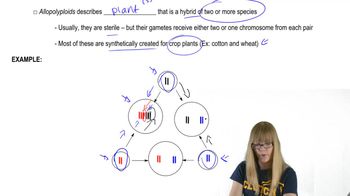Table of contents
- 1. Introduction to Genetics51m
- 2. Mendel's Laws of Inheritance3h 37m
- 3. Extensions to Mendelian Inheritance2h 41m
- 4. Genetic Mapping and Linkage2h 28m
- 5. Genetics of Bacteria and Viruses1h 21m
- 6. Chromosomal Variation1h 48m
- 7. DNA and Chromosome Structure56m
- 8. DNA Replication1h 10m
- 9. Mitosis and Meiosis1h 34m
- 10. Transcription1h 0m
- 11. Translation58m
- 12. Gene Regulation in Prokaryotes1h 19m
- 13. Gene Regulation in Eukaryotes44m
- 14. Genetic Control of Development44m
- 15. Genomes and Genomics1h 50m
- 16. Transposable Elements47m
- 17. Mutation, Repair, and Recombination1h 6m
- 18. Molecular Genetic Tools19m
- 19. Cancer Genetics29m
- 20. Quantitative Genetics1h 26m
- 21. Population Genetics50m
- 22. Evolutionary Genetics29m
21. Population Genetics
Allelic Frequency Changes
Problem 39a
Textbook Question
New allopolyploid plant species can arise by hybridization between two species. If hybridization occurs between a diploid plant species with 2n = 14 and a second diploid species with 2n = 22, the new allopolyploid would have 36 chromosomes. Is it likely that sexual reproduction between the allopolyploid species and either of its diploid ancestors would yield fertile progeny? Why or why not?
 Verified step by step guidance
Verified step by step guidance1
Step 1: Understand the concept of allopolyploidy. Allopolyploidy occurs when two different species hybridize, and the resulting hybrid undergoes chromosome doubling, allowing it to become fertile. This process creates a new species with a combination of chromosomes from both parent species.
Step 2: Analyze the chromosome numbers of the parent species. The first diploid species has 2n = 14 chromosomes, meaning its haploid number (n) is 7. The second diploid species has 2n = 22 chromosomes, meaning its haploid number (n) is 11.
Step 3: Determine the chromosome composition of the allopolyploid. The hybrid initially inherits one set of chromosomes from each parent species, resulting in 7 + 11 = 18 chromosomes. After chromosome doubling, the allopolyploid has 2 sets of chromosomes from each parent species, resulting in 2(7 + 11) = 36 chromosomes.
Step 4: Evaluate the compatibility for sexual reproduction between the allopolyploid and its diploid ancestors. Fertile progeny require homologous chromosomes to pair during meiosis. The allopolyploid has 36 chromosomes, while the diploid ancestors have 14 and 22 chromosomes, respectively. The lack of homologous pairing between the allopolyploid and either diploid ancestor would likely prevent the formation of fertile progeny.
Step 5: Conclude that sexual reproduction between the allopolyploid and either diploid ancestor is unlikely to yield fertile progeny. This is because the chromosome sets of the allopolyploid and the diploid ancestors are not compatible for proper meiotic pairing, leading to sterility in the offspring.
 Verified video answer for a similar problem:
Verified video answer for a similar problem:This video solution was recommended by our tutors as helpful for the problem above
Video duration:
2mPlay a video:
Was this helpful?
Key Concepts
Here are the essential concepts you must grasp in order to answer the question correctly.
Allopolyploidy
Allopolyploidy is a form of polyploidy that occurs when two different species hybridize, resulting in a new species with multiple sets of chromosomes from both parents. In this case, the new allopolyploid plant species has a chromosome number of 36, which is the sum of the chromosome sets from the two diploid parents (14 + 22). This genetic makeup can lead to unique traits and adaptations but also complicates reproduction with the parent species.
Recommended video:
Guided course

Allopolyploidy
Chromosome Compatibility
Chromosome compatibility is crucial for successful sexual reproduction. For an allopolyploid to produce fertile offspring with its diploid ancestors, the chromosome numbers must align properly during meiosis. In this scenario, the allopolyploid has 36 chromosomes, while the diploid parents have 14 and 22 chromosomes, respectively. This significant difference in chromosome number can lead to issues during gamete formation, often resulting in sterile progeny.
Recommended video:
Guided course

Chromosome Structure
Fertility and Hybridization
Fertility in hybridization depends on the ability of the hybrid organism to undergo meiosis and produce viable gametes. In many cases, hybrids between species with differing chromosome numbers are sterile due to improper pairing of chromosomes during meiosis. Given that the allopolyploid has a different chromosome count than its diploid ancestors, it is unlikely that sexual reproduction would yield fertile progeny, as the genetic mismatch can hinder successful gamete formation.
Recommended video:
Guided course

Drosophila P Element
Related Videos
Related Practice
Textbook Question
The human melanocortin 1 receptor gene (MC1R) plays a major role in producing eumelanin, a black-brown pigment that helps determine hair color and skin color. Jonathan Rees and several colleagues (J. L. Rees et al., Am. J. Human Genet. 66(2000): 1351–1361) studied multiple MC1R alleles in African and European populations. Although this research found several MC1R alleles in African populations, MC1R alleles that decrease the production of eumelanin were rare. In contrast, several alleles decreasing eumelanin production were found in European populations. How can these results be explained by natural selection?
567
views


